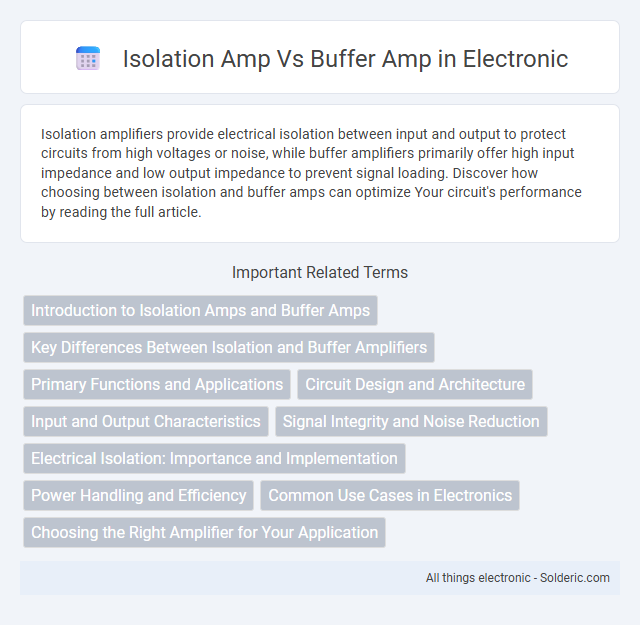Isolation amplifiers provide electrical isolation between input and output to protect circuits from high voltages or noise, while buffer amplifiers primarily offer high input impedance and low output impedance to prevent signal loading. Discover how choosing between isolation and buffer amps can optimize Your circuit's performance by reading the full article.
Comparison Table
| Feature | Isolation Amplifier | Buffer Amplifier |
|---|---|---|
| Primary Function | Electrical isolation between input and output to prevent ground loops and noise | Impedance matching and signal buffering without gain |
| Signal Gain | Can provide gain or unity gain with isolation | Typically unity gain (gain = 1) |
| Input Impedance | High input impedance, varies by design | Very high input impedance (megaohms to gigaohms) |
| Output Impedance | Low output impedance suitable for driving loads | Low output impedance for driving heavy loads |
| Noise Reduction | Effective at eliminating noise due to isolation barrier | No isolation--noise reduction depends on design |
| Applications | Medical devices, industrial sensors, data acquisition systems | Signal conditioning, impedance matching, preventing loading effects |
| Complexity | More complex and costly due to isolation components | Simple and cost-effective |
| Power Supply | Requires isolated power supply | Powered by the same supply as the signal source |
Introduction to Isolation Amps and Buffer Amps
Isolation amps and buffer amps serve distinct roles in audio signal processing. Isolation amplifiers electrically separate input and output signals to prevent ground loops and interference, ensuring clean audio transmission. Buffer amplifiers provide impedance matching, preventing signal loss and maintaining signal integrity when connecting different audio components.
Key Differences Between Isolation and Buffer Amplifiers
Isolation amplifiers provide galvanic isolation to prevent ground loops and reduce noise, ensuring signal integrity in sensitive measurement applications. Buffer amplifiers primarily offer impedance matching and signal amplification without isolation, maintaining signal strength while protecting circuit integrity. Isolation amps handle voltage level shifts and noise immunity, whereas buffer amps focus on signal conditioning and drive capability.
Primary Functions and Applications
Isolation amplifiers provide electrical isolation between input and output signals, preventing ground loops and protecting sensitive equipment in high-voltage environments. Buffer amplifiers mainly serve to increase input impedance and drive low-impedance loads without signal distortion, ensuring signal integrity in measurement and sensor circuits. Both types are essential in instrumentation, with isolation amplifiers used for safety and noise reduction, and buffer amplifiers employed for signal conditioning and impedance matching.
Circuit Design and Architecture
Isolation amplifiers use galvanic isolation through transformers or optical couplers in their circuit design to prevent ground loops and noise interference, ensuring accurate signal transmission in noisy environments. Buffer amplifiers feature a high-input-impedance voltage follower architecture designed to provide unity gain and drive heavy loads without signal distortion. Your choice between isolation and buffer amps depends on whether you need signal isolation or impedance matching in your specific application.
Input and Output Characteristics
Isolation amps provide high input impedance and low output impedance, ensuring signal integrity by preventing load effects and reducing noise interference between stages. Buffer amps exhibit unity gain with minimal signal distortion, offering consistent voltage levels while isolating input from output to maintain signal stability. Understanding these input and output characteristics helps you select the right amplifier to optimize signal transmission in your audio or measurement systems.
Signal Integrity and Noise Reduction
Isolation amplifiers enhance signal integrity by providing galvanic separation between input and output, effectively eliminating ground loops and minimizing electromagnetic interference. Buffer amplifiers maintain signal amplitude and prevent source loading but do not inherently isolate noise sources, making them less effective in reducing interference. You should choose an isolation amplifier when critical noise reduction and preservation of signal accuracy are required in complex or noisy environments.
Electrical Isolation: Importance and Implementation
Isolation amps are designed to provide electrical isolation between input and output, preventing ground loops and reducing noise interference in sensitive audio or measurement systems. Buffer amps offer impedance matching and signal amplification but typically lack the galvanic isolation necessary to protect your equipment from voltage spikes or grounding issues. Ensuring proper electrical isolation with isolation amps is crucial for maintaining signal integrity and safeguarding connected devices in complex setups.
Power Handling and Efficiency
Isolation amps typically have higher power handling capacities to prevent signal degradation and protect sensitive audio equipment, while buffer amps emphasize maintaining signal integrity with lower power consumption. Buffer amps excel in efficiency by using minimal current to preserve voltage levels without amplification, ideal for driving long cable runs or multiple inputs. Your choice depends on whether you need robust power management or optimized energy efficiency in your audio setup.
Common Use Cases in Electronics
Isolation amps are primarily used to prevent ground loops and protect sensitive equipment by electrically separating input and output signals, making them ideal for medical devices, industrial sensors, and data acquisition systems. Buffer amps provide high input impedance and low output impedance to stabilize signal levels without altering the waveform, commonly employed in audio equipment, analog signal processing, and measurement instruments. Your choice depends on whether signal integrity across isolation barriers or impedance matching and signal driving is the priority.
Choosing the Right Amplifier for Your Application
Isolation amplifiers provide galvanic isolation to prevent ground loops and reduce noise, making them ideal for sensitive or high-precision measurements in industrial or medical environments. Buffer amplifiers offer high input impedance and unity gain, perfect for impedance matching and signal stabilization in audio and instrumentation circuits. Understanding your application's need for noise immunity or signal buffering helps you choose the right amplifier for optimal performance.
Isolation amp vs Buffer amp Infographic

 solderic.com
solderic.com